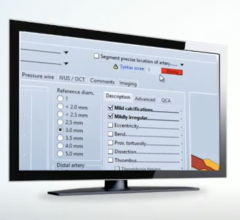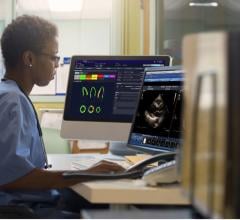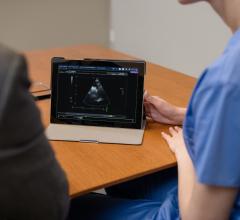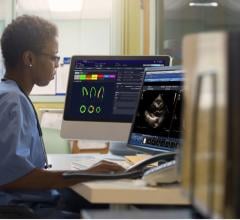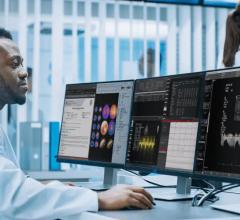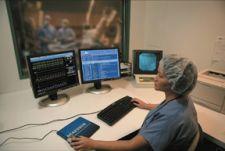
Turnaround times are faster with a single database. Photo courtesy of McKesson.
When it comes to collecting patient data, the ability to manage that information often becomes more crucial than the speed at which it is collected. But ensuring that the right data gets to the right person when needed often presents some challenges in hospitals that have installed best-of-breed systems or whose budgets have prevented them from purchasing some of the newer, integrated solutions.
Ideally you want clinical data collected in the cath lab to flow directly into the patient’s chart and be readily available to anyone accessing the department’s cardiovascular information system (CVIS) or the main hospital information system (HIS).
Additionally, cardiologists and cardiovascular surgeons want to be able to access this information — as well as all diagnostic images — not only from a hospital-based workstation, but also from their home or office.
Aware of growing demands in the field, vendors are stepping up to the plate.
Improved data transfer
The need for a more integrated system led Lima Memorial Hospital in Lima, Ohio, to the Horizon Cardiology system by McKesson Corp.
Ann Pohl, the hospital’s administrative director of cardiovascular services, says that with three new catheterization labs, the hospital had outgrown its old system and that attempts to create an interface to the American College of Cardiology (ACC) database were not very successful. “For us, a lot of that data could have just been scraped over to the ACC database,” she said.
Last year, this 325-bed hospital with seven privileged cardiologists went live with McKesson’s hemodynamics and echocardiography solutions.
Complete with real-time procedure notes charting and a customizable vitals chart, the hemodynamic monitoring and information management system allows patient demographics, clinical hemodynamic data, hemodynamic waveforms, cardiac images and procedural information to flow seamlessly into one complete cardiac patient record.
Pohl says not only has this improved overall workflow, but also has improved both patient care and safety. “We’re not entering multiple things into different systems,” she said, adding that if data has to be entered multiple times, there is a greater chance for errors to occur.
The system also has increased patient turnaround times because physicians no longer have to ask nurses about specific procedures or what equipment was used. “If they’re documenting or doing their reporting, it’s already charted for them so they can move quicker,” Pohl said.
Bob Baumgartner, senior product manager for cardiology in McKesson’s Medical Imaging Group, explains that while modules can be purchased and run separately, they all share a common database. “Because they’re sharing the same database, a physician can go to any workstation to finish his report while others are working on theirs.”
Clinicians also can access the information via an ADT interface with the Meditech HIS, Pohl notes.
Baumgartner says that while interfacing has been problematic with systems that use separate databases, that’s not the case with the McKesson product. “Cardiovascular medicine is a nonlinear workflow,” he said. “If you want to interface systems, you have to turn it into a linear workflow. But with a single database, there’s no problem.”
As for echocardiography images, Pohl says physicians can now view them online. “Our cardiologists do a lot of community outreach so they can pull up echos and read them between patients.”
Baumgartner says all cath lab images are compressed for transfer over the Internet and that physicians can view them at home via a virtual private network.
More reliable data
Data coming out of the cath lab is more reliable since the roll-out in June 2007 of Xper Information Management Physiomonitoring 5, offered by Philips Medical Systems, says Scott Cochran, RCIS manager of Cardiology and Imaging Services at Carson Tahoe Regional Medical Center in Carson City, Nev. “With the system’s improved hemodynamic platform, you can be confident in the numbers you get,” he indicated. “And the reliability of hemodynamic parameters improves patient care.”
Plus, he noted, “With the data collection tool you can collect all data elements that go into ACC and download them right into the ACC database.”
The launch by Philips of the Xper suite of products came as a result of the company’s acquisition of Florida-based Witt Biomedical Corp. in 2006.
Philips claims that the new Xper system offers instantaneous hemodynamic results and editable coronary and vascular tree images linked to the clinical database, and that it features robust charting and logging; four invasive pressure channels, 12-lead ECG, NIBP, SpO2, temperature, respirations and optional ETCO2; integrated thermal cardiac output; vitals signs capture with trending; and user-defined alarms.
Cochran says the hospital also is running the Xper Information Management Inventory Coordinator, which tracks all bar-coded inventory items in the inventory database, but has yet to roll out the scheduling module. “My plan was to start out slow and explore other possibilities,” he explained.
The only hospital in Carson City, Carson Tahoe Regional Medical Center is a two-year-old facility that is licensed for 140 beds. It opened its open-heart surgery and interventional cardiology unit in 2006 and is served by 12 cardiologists. The Xper system resides on a server in IT, Cochran says, and there are five workstations in the cath lab. Plans are under way to upgrade the hospital’s IT backbone. But until then, the Xper system is being interfaced to a McKesson HIS via a one-directional feed.
Improved connectivity
Exempla Lutheran Hospital in Denver, Colo., has been able to seamlessly move patient information from the cath lab to wherever it’s needed — including the ACC database, which is included as part of the CVIS – since going live with Mac-Lab IT from GE Healthcare.
Gregg Helser, RN, Exempla Lutheran’s cardiology systems administrator, says collecting data from the patient in the pre-op holding area begins the process. “As we close the patient on the nurse’s workstation, we continue the patient in the cath lab. When the case is closed on Mac-Lab, the data flows into the CVIS.”
Also, any one of the 20 cardiologists who serves the hospital can remotely access this data and access diagnostic quality images through a secure physician portal, he says.
Powered by the Centricity Cardiology Information System, Mac-Lab IT is a completely integrated hemodynamic monitoring system that is scalable so hospitals can take advantage of its core features, and then add additional functionality as needed. Among the core features are: hemodynamic monitoring and recording; multiple physician documentation; electronic form-based data entry; custom forms; macro protocols; automated list sharing; inventory reports; interactive statistical reporting; domain security; and a redundant hard drive.
Some options include image capture with bi-plane capabilities; a bi-directional GE X-ray and invasive monitoring interface; physician reporting (including cath, echo, nuclear, stress and/or surgery); a MUSE CV interface; an ADT interface; a billing/charge capture interface; and Web scheduling.
The system boasts a real-time, modular TRAM acquisition unit that can be configured to acquire 12-lead ECG, ST-segment analysis, respiration rate, temperature, thermodilution cardiac output, sidestream or mainstream end tidal CO2 waveform, SpO2 pleth waveform, NIBP and up to four invasive pressures.
Aside from its use in monitoring patients while in the hospital, this system also is providing a wealth of tracking data. “All that data is available for abstracting,” said Helser. “We use it to track patients and to document all procedures.”
Even physicians are tracked, he said, “We’re able to tell what physicians use the most equipment and who has the longest wait times.”
The rapidity of data collection, its manageability and its easy accessibility not only has streamlined clinical and administrative processes, but also has led to some very tangible results.
Patient satisfaction is higher as a result of improved throughput in the cath lab, Helser says. And patient safety and outcomes have improved. Door-to-flow times (from chest pain to cath lab) have been reduced to about 30 minutes. And there has been a marked improvement in outcomes for patients with congestive heart failure, he says.
Licensed for just over 400 beds, and with a 25,000-square-foot wing dedicated solely to cardiology, Exempla Lutheran is one of three hospitals in the Exempla Healthcare system. The other two are Exempla St. Joseph (450 beds) and Exempla Good Samaritan (200 beds).
All three hospitals are running the Mac-Lab system, but not all have added the same options, Helser says.
Even so, all three hospitals report gains in efficiency due to the connectivity between Mac-Lab’s own applications and with those of other hospital systems.

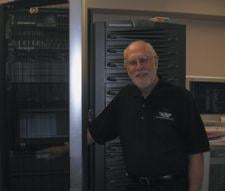

 June 27, 2022
June 27, 2022 

